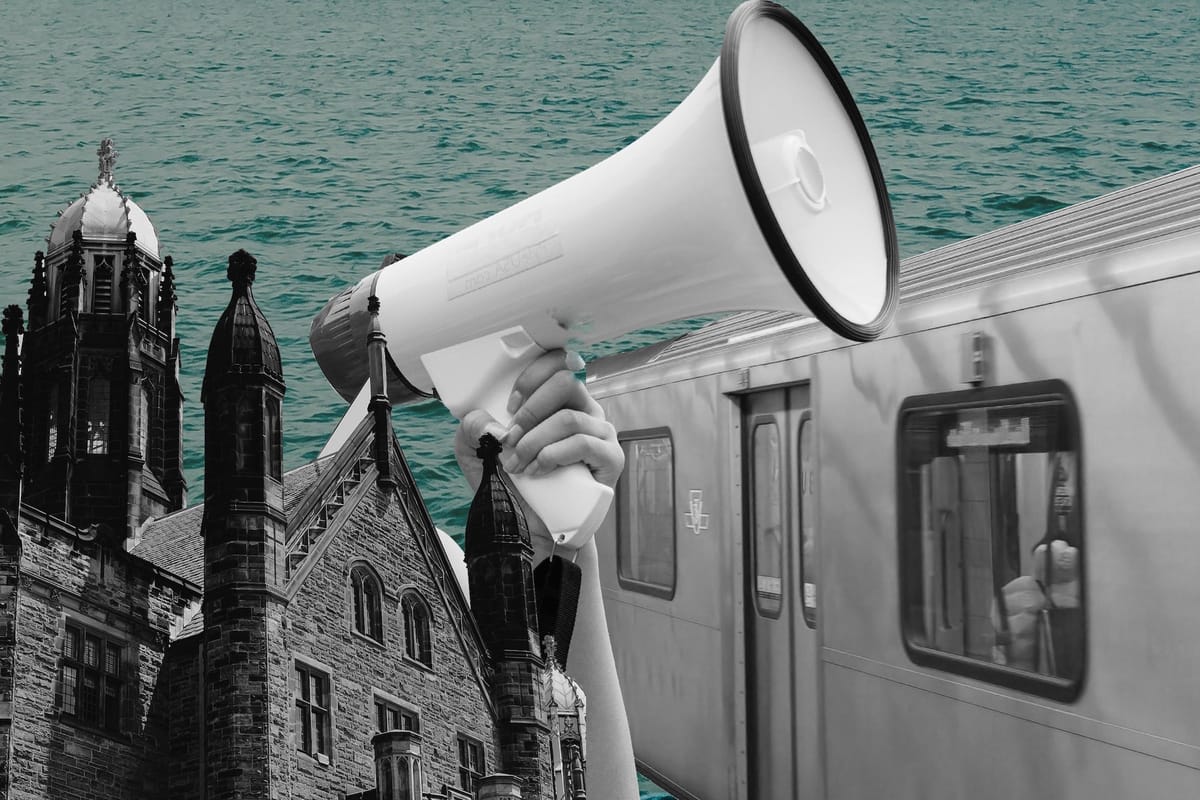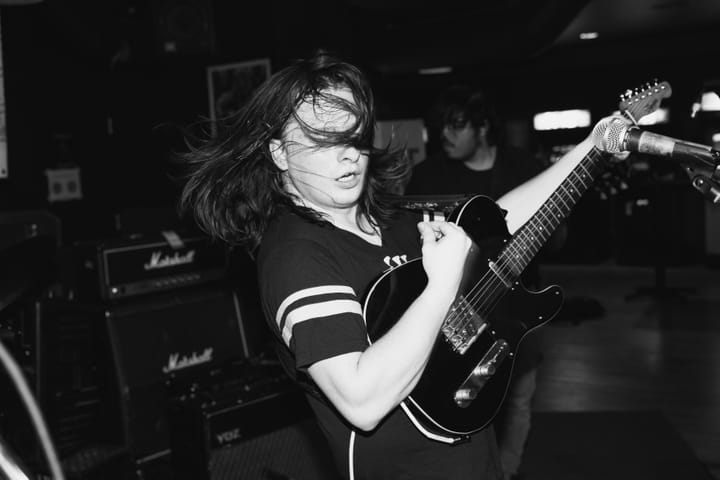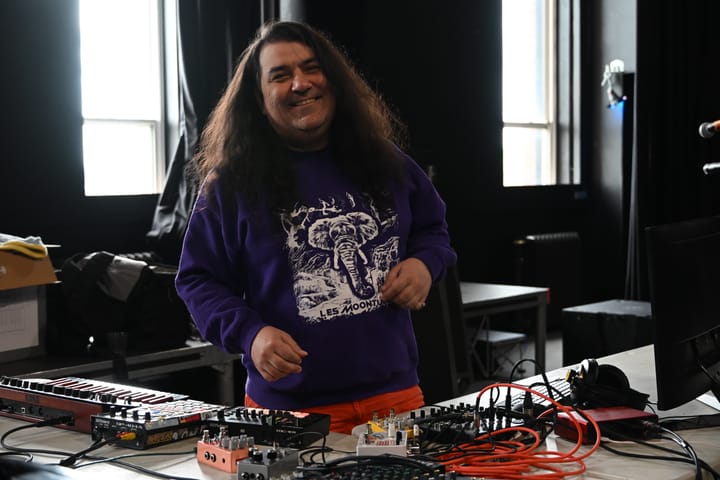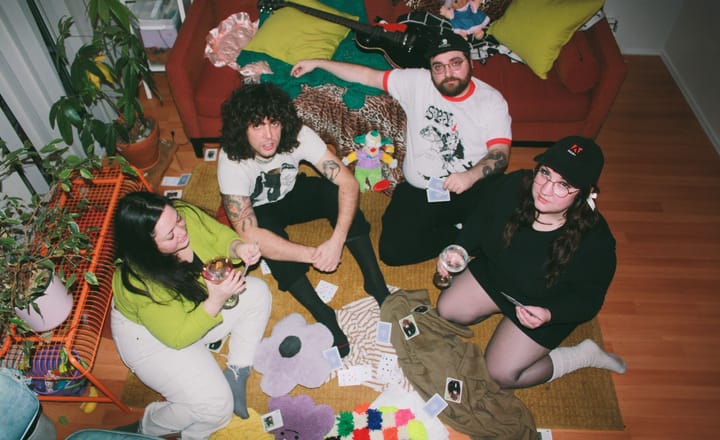
Are You Listening? The Power of Paying Attention Explored Through Audio Archiving
We all feel sound, regardless of if we are hearing, non-hearing, aware of ourselves experiencing it, or not. We share a relational coexistence with our sonic environment, a constant, multi-directional chorus of communications that every bit of this world is co-creating at all times. There are stories being told and memories being formed, by footsteps, rumbling tummies, the groundwater flowing beneath our feet, trees falling in the forest that no one is around to hear, bombs dropping on entire generations of bedtime stories, simmering stews, and heartbeats, and the ensuing silence of our institutions that claim to lead.
I set out to explore the role music and sound play in the collective experience and eventual memory of this historical moment, in the midst of scarcity, civil unrest, and movement towards revolution. With my Zoom Handy Recorder, I ask, what does the social climate sound like? I strive for the impossibility of capturing this strange, dissonant moment of living in Tkaronto, in the peak of privilege, where tires continue to squeal, and billboards continue to sell us wellness just as nature floods our highways, and supposed leaders sneak in the night to destroy what’s left of our natural world. It’s grim, and it’s rich with simple pleasures, protest, and people playing, creating, and fighting for the rights of the living.
[U of T] A child leads the chant "Ceasefire Now", 2024-05-11
Surrounded by gated grass and gothic architecture, a child’s voice breaks as he leads a crowd of adults in calling for a ceasefire. The young child, between 5-10 years old, holds a megaphone over a crowd of protesters and screams for the adults to stop dropping bombs on innocents. This child is surrounded by a crowd of protesters looking at them and answering their call while police officers line the entrances to the large stone campus buildings and their exits to the streets. Meanwhile, the people are answering exploitation, genocide, and police violence with rhythm, runs, call and response, all the makings of a timeless song.
[Downtown] A group of protesters chants “Long live the Intifada”, 2024-05-11
This well-worn chant reminds us of the historic fight for freedom, this current chorus a continuation of a long line of Palestinian resistance against the imperial rule of the Israeli occupation.
[Rosedale Station] Accordion buskers, 2024-07-15
A couple of buskers graced the evening commute with their rendition of “My Way” or, as I just discovered, “Comme D’Habitude” by Claude Francois, played on a squeezebox accordion along to an instrumental backing track. The robotic voice of the pre-programmed station announcements places us in a moment of arrival at Rosedale Station, one of few above-ground stops along the transit lines.
It’s worth noting that this pair of performers were not of the designated “Subway Musicians” stationed in their assigned performance space at the city’s discretion but rather a duo in motion with its fellow passengers. They were freeform moving musicians entertaining strangers on their commute home. I myself am partial to wearing headphones or simply letting the subway sounds overtake my brainwaves; the screeching of wheels against tracks, the coughs and sneezes of the unmasked masses, and the ever-evolving (and increasingly foreign) dialects of teens talking. But when the brightness of the accordion made its way past my ear buds, the tune began to uplift me.
Looking around, I perceived most people in the vicinity to be enjoying the entertainment, or at least intrigued, broken for a moment from their dissociative stares. I observed relief, curiosity, and strangers glancing shyly at one another with the faintest of smiles making their way around the crowd of weary travelers. Respite, I thought. A moment to be all here, among others, aware of ourselves and each other, even if we are trapped in a metal tube underground, longing desperately to make it home without any incidents.
[Summerhill Station] Yeller, 2024-07-15
In classic city fashion, the peace lasted only a moment, disrupted by an angry voice yelling at the buskers: “TURN IT DOWN.” I’m quickly sobered back into my usual state of vigilance while riding the Toronto Transit Commission (TTC). While I respect the need for quiet personal space and whatever other hidden emotions were motivating the objector’s actions, I couldn’t help but think about how some bodies are entitled to treat public space like personal space while others are subject to the entitlement of others. Despite the buskers turning down their volume, the yeller escalated, forcing the buskers to yield with a nod and move down the train, wheeling their speaker behind them.
This exchange got me thinking about public space and the function of curated performance. The TTC busker program runs an application process once every three years. It recently closed and will reopen in 2027. Musicians have to meet eligibility requirements and provide legal documentation to apply for a permit and pay an annual fee of $45.75. According to the official TTC website, “Prior to 1979, the TTC didn’t allow musicians to perform in the subway. However, after a pilot project at eight stations in 1980, nearly three-quarters of customers indicated that they were in favour of music in the system.” The TTC Underground Sounds Subway Musicians Program “enriches the atmosphere of TTC subway stations for our customers, brightening their daily commutes and improving their overall transit experience.”
Though the majority of paying passengers appeared to enjoy the impromptu performance, the single voice of an angered, suit-wearing individual with publically protected identity markers changed the course, an example of the privileged few controlling the movement of the disenfranchised many.
[Christie Pitts] People in the park, 2024-06-27
Wandering home after work one day, I decided to take a rest in the park before subjecting myself to the subway. I found people in pairs and groups, connecting through conversation, laughter, and music; a simple and welcome reprieve.
[North York] The flood, 2024-07-16
After trying to manage the water pouring through the windows of my home, I finally yielded to the futility and decided to set up my recorder and listen instead, as 97.8mm of rain flooded the city. With major weather events rising in both frequency and severity, I took a moment to be grateful for my safety, knowing these days are numbered in a city with no infrastructure for the ensuing climate catastrophe.
[Uptown] Lone protester on foot at rush hour, 2024-07-31
The day the Israeli government assassinated Ismail Haniyeh, leader of Hamas, I spotted a solo person protesting on foot, walking up and down Sheppard Avenue with a speaker, replaying a clip of dialogue on loop. The distorted sound was met with the occasional car horn – of solidarity or opposition, it was hard to know – but mostly, it was met with the mundane groan of traffic at rush hour.
Since October 7th, this was only the second time I saw blatant political activity at this intersection, the former instance being a solo person silently carrying a Palestinian flag back and forth across the crosswalk, waiting each time for the walk signal to change before quietly crossing with the other pedestrians.
[Harbourfront] The lake beneath the cars and the people, 2024-08-07
On a Wednesday after work I decided to wander around the city, seeking sounds. I knew I wanted to find the water. There’s something about being stuck on the TTC, behind a desk, at the poverty line, that makes me crave motion. I started by the docks, listening to the slosh of buoys against the concrete and the groans of workers dragging a piano onto a dock for one of those pricey pirate concerts popular amongst tourists. I paused to collect the sound of Lake Ontario slamming again and again against the wall beneath the boardwalk. I thought of it trapped down there… gridlocked, just like us. Still, always moving. Ancient and essential. I disrupted the rush of traffic to listen and acknowledge the lake and its motion, the way it persists under the frantic footsteps of the unbothered masses.
[Geary Art Crawl] Kureiji Sukētobōdo Ongaku + Crowd, 2024-09-22
It’s Sunday evening. The sun was never really visible through the cloudy grays, but it’s going down, and the bittersweet turn of the season is in the air. The bustle of the street festival rises over the hushed violence this city was built on, just as pavement covers the footpath formed by the Indigenous peoples of this land, connecting what are colonially known as the Don River and the Humber River. The Geary Art Crawl is a fairly new festival-like celebration of local arts and culture, taking place just a block away from Davenport Road where this historical trail remains. There is also life, the amalgamation of voices in all different languages, children and visiting parents, friendships, collaborations, bicycle wheels weaving through the crowd... and buskers, of course.
[Geary Art Crawl] Bobby Gadda + Crowd, 2024-09-22
Using a keyboard, a microphone, and a looper, Bobby Gadda invites participation from passersby with the sign “YOU MAKE A SOUND I’LL MAKE A BEAT.” This created an experience of spontaneous co-creation not only in the making of the beat but in the larger soundscape occurring at the art crawl as well, with more and more voices moving through the streets trailed by the laughter of people hearing themselves in tandem with others.
[Emily Jung] Labour in the Arts Open Letter: “What is the future of a performing arts sector that is afraid to condemn genocide and ethnic cleansing?”, 2024-09-09
I spoke with Emily Jung, an interdisciplinary artist and arts worker and co-founder of Labour in the Arts. With a background in arts administration and a focus on arts labour in Canada, Jung has dedicated the past few years trying to understand why things are the way they are, noting that “inherently, social justice movements are not separate from the activism for labor [...] it's really linked to everything, it's linked to feminism [and] the ongoing movement for Palestine [and] the liberation of people and non-humans.” We discuss the intersections between arts, labour, and activism, in relation to Labour in the Art’s open letter to PACT, the Professional Association of Canadian Theatre. The open letter asks, “What is the future of a performing arts sector that is afraid to condemn genocide and ethnic cleansing?” and issues a number of calls to action to the organization, which has yet to call for a ceasefire or condemn Israel for committing genocide and war crimes against the Palestinian people.
Though organizations like PACT need to take accountability for their role in perpetuating violence and stand in solidarity with the artists and workers that make up the labour force they claim to serve, Jung reflects on the small successes of the open letter: “Now I have, with this collective, a congregation of sorts. We have now 464 people across the country who would put their name into a letter that calls out our industry, and so that gives us a really good infrastructure to continue having conversations, not just about Palestine, but about arts labor going forward.”
Jung brings up a lot of interesting nuances about how institutions function, what role they do play, and the potential power they can have in supporting arts and social justice movements in Canada.
[LIA] Emily Jung on the intersections of labour activism, 2024-09-09
When asked to reflect on which sounds stand out as characteristic to the city and the moment, Jung unsurprisingly referenced traffic, the sound of people playing content out loud on their phones, and a day-to-day, quiet humming.
Claiming cultural narratives through storytelling, Aliyah, 2024-09-09
Aliyah is a local artist using audio visual techniques including field recordings, composition, collage, and projection to tell stories. Aliyah speaks to the importance of storytelling in defining one’s own identity within the context of western colonial narratives that dominate space and limit who can tell their stories and how. “Part of me has felt and seen fragmentations in myself and in my peers when we’re not given access to our own histories[...]we’re being told stories that we are supposed to then acclimate and fit into.”
The erasure of cultural narratives and languages has been and continues to be deliberate. A people stripped of voice, a platform, and credibility are a disempowered people, easy to control, dismiss, and annihilate because the opposite is true. “Stories are also humanizing, so to be able to tell my story is a privilege in contexts that dehumanize me based on who I am[...] so there is this urgency in not only telling my own stories, but also pushing for other people who have been denied that.”
[Aliyah], The role of the artist in collective liberation, 2024-09-09
Aliyah puts an artist’s purpose plainly: “If my life is not honouring life, I am not honouring myself.” I often wonder how it can be that this is not a baseline understanding among people, regardless of how much an artist they are or consider themselves to be. But perhaps it’s the makings of an artist that are also the makings of an empath: the ability to perceive difference and likeness simultaneously, and to imagine beyond the borders of circumstance. “To be interested and curious about the world and to be able to talk about it and to make space to talk about it - not just to profit off of it but to engage creatively with life… in honour of it,” Aliyah reflects, “That has to do with human rights. That has to do with sustainable ways of making. That has to do with considering the impact your work has.”
Aliyah recently presented the final of four residency showings in the Southern Cross at the Tranzac. The project, "Sounds of the Shadows," Responding to the Privatisation of Ontario Place, is described as “soundscapes and projections of a floating shadow of resistance,” using found sounds collected from the land that has since been barred off to be converted into a private spa. The soundscapes included bird sounds collected from the native species of birds that will be disrupted and displaced when their habitat is destroyed by the Ontario government. Documentation of Aliyah’s residency will be coming to her website.
This project is one of many that engages with voice – of the environment, inanimate objects, and generations past, with respect to the voices that are excluded from cultural narratives and an understanding that one relates to the next.
“I think the role of the artist is political engagement. You’re talking about attention. You’re talking about culture. You are shaping this.”
Sources:
- Great Lakes Guide
- Linking soundscape composition and acoustic ecology, Hildegard Westerkamp
- Native Land
- Palestinian-Canadian Academics and Artists Network
- TTC Underground Sounds Subway Musicians Program
Read more

Sentries: Multifaceted Noise Rock

Step Into Little Stone Crow's World

